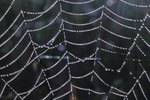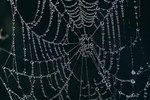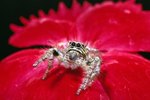Yellow sac spiders prefer the great outdoors but will venture indoors to hunt tasty bugs. Although the spiders don’t actively seek out people, they will bite humans if threatened. Most people experience only mild reactions to yellow sac spider bites, but some develop more serious symptoms that require medical care.
They Are What They Eat
Yellow sac spiders get their name from the sacs they build to conceal themselves while they wait for prime hunting hours in the evening. The spiders are light yellow to yellow-green in color. Some have darker stripes on their abdomens that look orange or brown. The University of Michigan's Animal Diversity Web site says the spiders' body colors vary by the type of insects they eat and notes that spiders who eat flies tend to have grayer bodies, while spiders that eat red-eyed fruit flies look slightly red. Yellow sac spiders range in length from slightly less than a quarter-inch to three-eighths of an inch. Male spiders’ bodies are a little smaller than the females', but they have longer legs.
Cozy Homes
Other spiders spend hours constructing intricate webs, but yellow sac spiders can create sacs in just 15 minutes. The spiders’ sacs are about an inch in length and look like small white cocoons. Yellow sac spiders build their sacs in the places bugs hang out; they prefer making their homes in weeds, in tall grass or under leaves. If you’ve ever noticed a small white cocoon in the corner of a room or at the spot where the ceiling and wall join together, you’ve probably hosted a yellow sac spider in your home.
Finding Food
Yellow sac spiders aren’t particular and will eat almost any insect or insect egg they find. Their front legs are longer than their other legs, which helps them hunt. The spiders use those legs to push aside leaves and vegetation to search for bugs. A collection of dark hairs at the bottoms of the spiders’ legs help them cling to trees and walls when they climb. When the weather turns colder, the insect population declines outdoors and the spiders begin entering homes and other buildings to find food.
Accidental Victims
When darkness falls, the yellow sac spider produces a silky thread and either drops to the floor or uses the thread as a sort of a bridge to another spot in the room. If the spider happens to drop onto your bed, he might bite you in his haste to escape from your clothing or sheets. You might notice a sharp, burning pain when a yellow sac spider bites you. In most cases, the bite will heal on its own without causing any major problems. Some people experience more severe reactions to the spider’s bite and can develop an ulceration at the bite site, fever, nausea, fatigue or abdominal cramps. A prescription antibiotic can help treat symptoms of a severe reaction.
References
Writer Bio
Working at a humane society allowed Jill Leviticus to combine her business management experience with her love of animals. Leviticus has a journalism degree from Lock Haven University, has written for Nonprofit Management Report, Volunteer Management Report and Healthy Pet, and has worked in the healthcare field.





